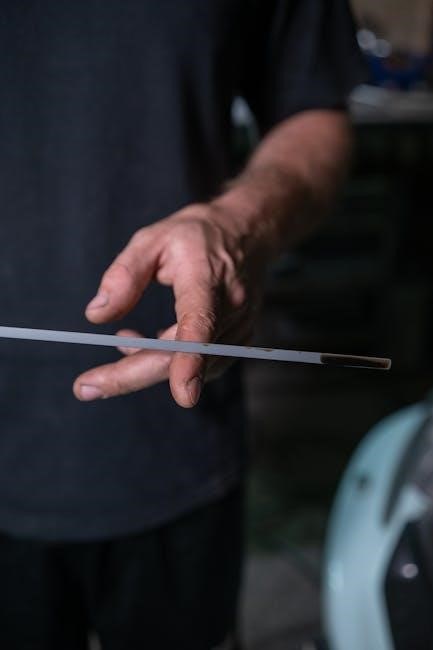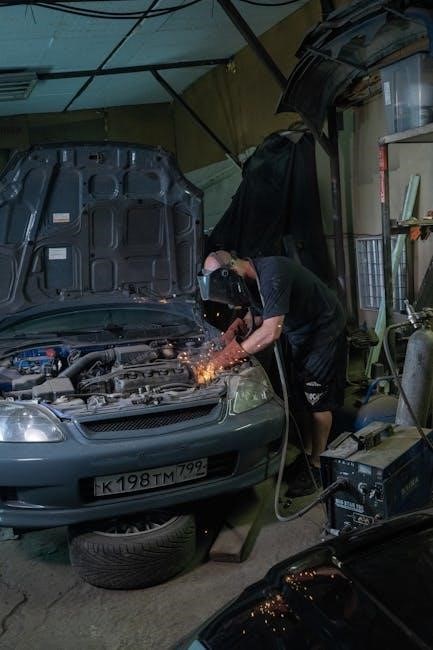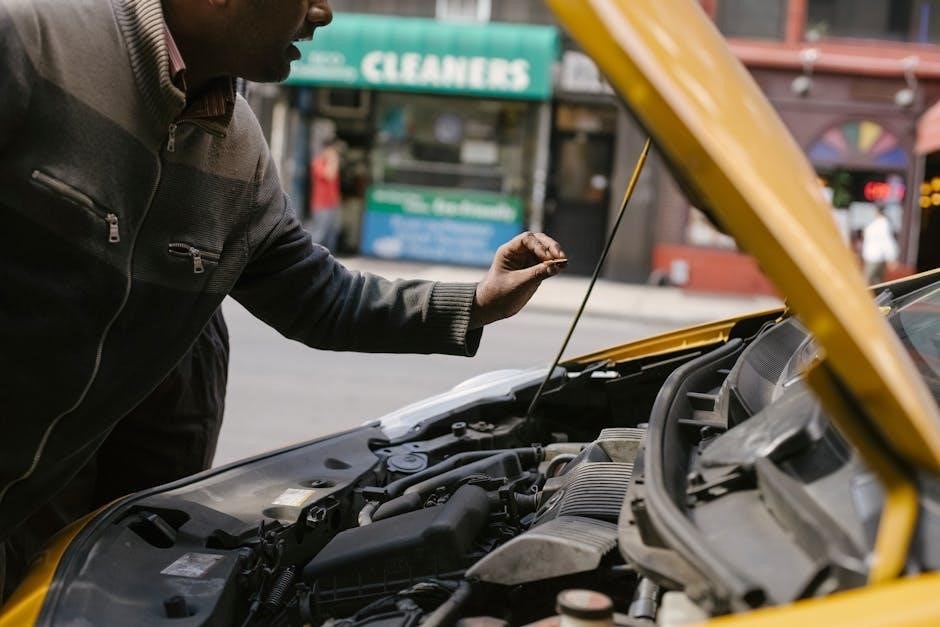The motor can be started manually with a rheostat‚ a variable resistor controlling current during startup. This method reduces inrush current and voltage‚ enabling smooth acceleration and protecting equipment from sudden surges.
Overview of Rheostat-Based Motor Starting
A rheostat-based motor starting method involves using a variable resistor to control current flow during startup. This approach connects an external rheostat to the motor’s rotor circuit via brushes and slip rings‚ limiting inrush current and voltage. It enables smooth acceleration‚ protects equipment from voltage spikes‚ and prevents power line dips‚ ensuring safe and efficient motor operation in various industrial applications.
Importance of Manual Control in Motor Systems
Manual control in motor systems provides precise control over startup and operation‚ ensuring safety and preventing damage from voltage spikes. It allows operators to adjust resistance smoothly‚ enabling gradual acceleration and protecting equipment. This method is reliable‚ simple‚ and versatile‚ making it ideal for industrial applications where direct human intervention is essential for specific motor requirements and operational adaptability.
Types of Motors Compatible with Rheostat Starting
DC motors and wound-rotor induction motors are compatible with rheostat starting‚ allowing for reduced inrush current and smooth acceleration during manual startup‚ ensuring optimal reliable performance.
DC Motors and Rheostat Compatibility
DC motors are well-suited for manual starting with rheostats‚ as the rheostat reduces the initial current and voltage‚ preventing sudden surges. By connecting the rheostat in series with the armature‚ the motor achieves smoother acceleration and better control during startup. This method is particularly effective for DC motors‚ ensuring reliable operation and protecting the motor from damage.
Wound-Rotor Induction Motors and Rheostat Applications
Wound-rotor induction motors often use rheostats for manual starting‚ as the rheostat connects to the rotor circuit via brushes and slip rings. This setup allows for reduced starting torque and current‚ minimizing stress on the motor. By gradually decreasing resistance‚ the motor achieves smooth acceleration‚ making rheostats a practical solution for controlling wound-rotor induction motors during startup.

Components of a Manual Rheostat Starting System
A manual rheostat starting system includes a rheostat‚ brushes‚ slip rings‚ and a motor starter. These components work together to regulate current and voltage during startup.
The Role of the Rheostat in Motor Starting
The rheostat plays a crucial role in motor starting by controlling the current flow. It reduces inrush current and voltage surges‚ protecting the motor and equipment from damage. By gradually increasing the current‚ it allows the motor to accelerate smoothly‚ preventing sudden stress on the system. This method ensures safe and efficient motor startup.
Brushes and Slip Rings in Rheostat-Based Systems
Brushes and slip rings are essential components in rheostat-based systems‚ enabling the connection of the rheostat to the motor’s rotor circuit. Brushes maintain contact with the rotating slip rings‚ allowing resistance to be applied or removed during startup. This setup ensures smooth control of current and voltage‚ facilitating gradual motor acceleration and protecting the system from sudden surges.
Motor Starter and Rheostat Integration
The motor starter and rheostat are interconnected to regulate current during manual starting. The starter switches power supply‚ while the rheostat adjusts resistance‚ controlling voltage and current flow. This integration ensures smooth acceleration by gradually increasing motor speed‚ preventing sudden surges and protecting both the motor and connected equipment from damage.
Step-by-Step Process of Manual Motor Starting
Set the rheostat to maximum resistance‚ connect power‚ and gradually reduce resistance to achieve full motor operation‚ ensuring smooth acceleration and preventing voltage surges.
Setting the Rheostat to Maximum Resistance
Starting the motor manually with a rheostat begins by setting the rheostat to maximum resistance. This step is crucial as it limits the initial current surge‚ preventing voltage drops and protecting the motor from damage. By starting at maximum resistance‚ the motor can gradually accelerate without risking electrical surges or equipment stress. This ensures a smooth and controlled startup process.
Connecting Power and Initiating Startup
With the rheostat at maximum resistance‚ securely connect the motor to the power supply‚ ensuring proper grounding for safety. Engage the power switch to initiate startup‚ monitoring the motor’s performance. This step ensures controlled current flow‚ protecting the motor from voltage surges and allowing gradual acceleration. Close observation during startup helps detect any anomalies‚ ensuring a smooth and safe initiation process.
Gradually Reducing Resistance for Full Operation
After initiating startup‚ the rheostat’s resistance is gradually reduced to minimize current surges. As resistance decreases‚ the motor accelerates smoothly to its rated speed. This step ensures efficient operation by allowing the motor to reach full performance without overloading. Continuous monitoring of current and voltage is essential to prevent excessive heating or power fluctuations‚ ensuring safe and optimal motor operation.
Safety Considerations and Precautions
Manual motor starting with a rheostat requires proper insulation to prevent short circuits. Ensure all components are correctly rated and avoid overload conditions for safe operation.
Potential Hazards of Manual Rheostat Starting
Manual rheostat starting can pose risks such as electrical surges‚ voltage drops‚ and overheating. High inrush currents may damage equipment‚ while improper resistance settings can lead to motor overload. Additionally‚ worn brushes or slip rings may cause arcing‚ creating fire hazards. Regular inspection and proper maintenance are essential to mitigate these risks and ensure safe operation.
Best Practices for Safe Motor Operation
Ensure proper setup and resistance adjustment to avoid voltage surges. Regularly inspect brushes‚ slip rings‚ and connections for wear. Maintain optimal resistance levels to prevent overheating. Monitor current levels during startup to avoid exceeding motor ratings. Always follow manufacturer guidelines for rheostat settings. Proper maintenance and adherence to safety protocols are crucial for reliable and safe motor operation.

Advantages and Limitations of Rheostat Starting
Rheostat starting offers smooth acceleration and reduced inrush current‚ protecting equipment. However‚ it is less efficient and requires manual adjustment‚ limiting its use in complex systems.
Benefits of Using a Rheostat for Motor Starting
A rheostat allows gradual voltage application‚ reducing inrush current and voltage surges. It enables smooth motor acceleration‚ protecting equipment from damage. Simple to operate‚ rheostats provide precise control during startup‚ making them ideal for manual motor starting in various industrial applications‚ ensuring efficient and safe initial operation of electric motors.
Drawbacks and Challenges in Industrial Applications
Despite its benefits‚ manual rheostat starting has limitations. It offers low efficiency due to energy loss in resistance. The method requires precise resistance adjustments‚ complicating speed control. Maintenance of brushes and slip rings is essential‚ adding to downtime. Additionally‚ rheostats are less scalable for complex systems‚ making them less favorable in demanding industrial environments compared to modern alternatives.
Applications of Manual Rheostat Starting
Manual rheostat starting is commonly used in wound-rotor induction motors and DC motor systems. It is ideal for industrial machinery requiring precise speed control during startup.
Industrial Scenarios for Rheostat-Based Motor Control
Manual rheostat starting is widely applied in manufacturing and construction for controlling wound-rotor induction and DC motors. It ensures smooth acceleration and precise torque control during startup‚ making it ideal for heavy machinery‚ cranes‚ and conveyor systems where gradual speed adjustment is critical for operational efficiency and safety.
Simple vs. Complex Motor Systems
Rheostat-based starting is ideal for simple motor systems requiring basic speed control and reduced inrush current. It is cost-effective and easy to implement in applications like small machinery. However‚ for complex systems with variable loads or high efficiency demands‚ advanced methods like soft starters are preferred due to their precise control and adaptability to dynamic conditions.
Comparison with Other Motor Starting Methods
Rheostats offer simple‚ cost-effective motor starting with basic speed control. Soft starters provide smoother acceleration and better efficiency for complex systems‚ making them preferred in industrial demanding applications.
Rheostat Starting vs. Soft Starters
Rheostat starting offers a basic‚ manual method for motor control‚ ideal for simple applications. Soft starters provide smoother acceleration‚ reduced voltage drops‚ and automatic control‚ making them more efficient for complex industrial systems. While rheostats are cost-effective and easy to implement‚ soft starters excel in reducing mechanical stress and enhancing operational efficiency‚ especially in demanding environments with high torque requirements and frequent startups.
Advantages of Rheostats Over Traditional Starters
Rheostats offer a cost-effective and straightforward method for motor starting‚ providing manual control and simplicity. They are well-suited for basic applications‚ enabling smooth acceleration and current regulation without complex automation. Unlike traditional starters‚ rheostats are easy to implement and maintain‚ making them a reliable choice for scenarios where simplicity and ease of operation are prioritized over advanced features.

Modern Alternatives to Manual Rheostat Starting
Electronic speed controllers and soft starters are modern alternatives to manual rheostat starting‚ offering precise control‚ reduced energy consumption‚ and improved efficiency in motor operations.
Electronic Speed Controllers and Their Role
Electronic speed controllers replace manual rheostats‚ offering precise control over motor speed and torque. They enable automatic adjustments‚ reduce energy consumption‚ and provide smooth acceleration. These advanced systems integrate seamlessly with modern motor technologies‚ ensuring higher efficiency and reliability compared to traditional rheostat-based methods‚ while minimizing wear on motor components and improving overall system performance.
Future Trends in Motor Starting Technology
Future trends emphasize advanced electronic controllers and smart systems for motor starting. Predictive maintenance and IoT integration optimize performance‚ while energy-efficient technologies reduce consumption. Solid-state starters and adaptive control algorithms are replacing manual rheostats‚ enabling real-time adjustments and seamless operation. These innovations enhance reliability‚ reduce wear‚ and align with sustainability goals‚ marking a shift toward smarter‚ automated motor control solutions.

Troubleshooting Common Issues
Common issues include faulty rheostat connections‚ worn brushes‚ or incorrect resistance settings. Regular inspection and maintenance ensure smooth motor operation and prevent startup failures.
Diagnosing Faults in Rheostat-Based Systems
Diagnosing faults in rheostat-based systems involves checking for worn brushes‚ faulty slip ring connections‚ or incorrect resistance settings. Signs of wear include excessive sparking‚ uneven resistance‚ or motor vibrations. Regular inspection of brushes and slip rings ensures proper electrical contact. Incorrect resistance can cause motor underperformance or startup failures‚ requiring adjustment or replacement of components.
Resolving Startup Failures
Resolving startup failures in rheostat-based systems often involves checking the rheostat’s resistance settings‚ ensuring proper brush contact‚ and verifying power supply. Worn brushes or faulty slip rings can prevent startup. Adjusting the rheostat to the correct initial resistance or replacing damaged components typically resolves issues. Always test the motor at low resistance after repairs to ensure smooth operation.
Maintenance and Care of Rheostat Systems
Regularly clean and inspect brushes and slip rings to ensure proper contact. Lubricate moving parts and check resistance settings. Replace worn components promptly to maintain efficiency and safety.
Cleaning and Adjusting Brushes and Slip Rings
Clean brushes and slip rings regularly using a soft brush or solvent to remove dust and debris. Adjust brushes to ensure proper contact and alignment. Lubricate pivot points if necessary. Misaligned or worn brushes can cause poor electrical contact‚ leading to inefficient motor operation or damage. Regular maintenance ensures smooth current transfer and optimal system performance.
Inspecting and Replacing Worn Components
Regularly inspect brushes‚ slip rings‚ and rheostat contacts for wear. Replace brushes showing excessive wear‚ pitting‚ or discoloration. Check slip rings for smoothness and even contact. Inspect the rheostat for dust or worn resistors. Replace faulty components promptly to ensure proper electrical connection and prevent motor damage. Proper maintenance extends system lifespan and reliability. Always use compatible replacement parts.